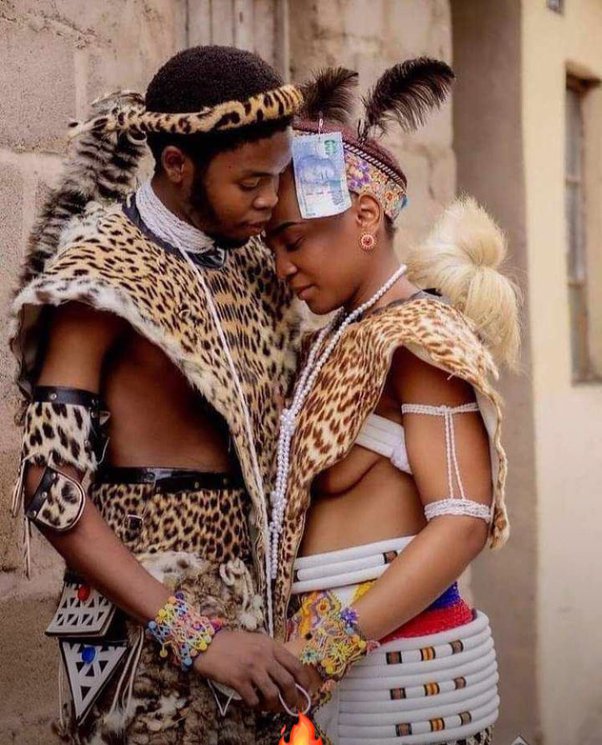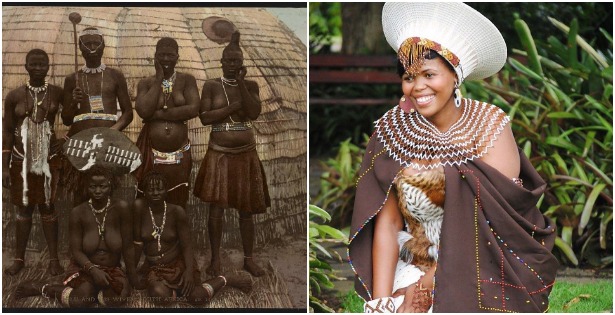- The Zulu people of South Africa are intentional about their dressing and as such have various attires for different purposes.
- Each attire serves as a differentiator of the phase a person is going through at the time.
- Although, the men and the women share similar attires when it comes to headdress, there are many other things they use to differentiate each other.
Zulu People: Women clothing
Women dress differently depending on where they are in life. The more they hide their bodies as they age and become married, the more.
No matter her size, weight, or whether she has a tiny or large bust, an unmarried girl (intombi) just wears a short skirt made of grass or beaded cotton strings; she wears nothing on top.
The back of the upper thigh rather than the naked breast is where Zulu people attach s3xual significance. She then dresses up and wears her hair short while wearing beading.
READ ALSO: Enchanting Zulu Princess: Girl captivates the hearts of netizens with joyful traditional dance
In addition to showing respect to her future family, when a young woman has been chosen or engaged, she lets her hair grow and covers her breasts with a colourful fabric to show the community that she has been spoken for.
Married ladies totally conceal their bodies, indicating that she is off limits. She’s covered head to knee in a thick cowhide skirt.
The leather is first processed to make it somewhat supple, after which it is cut into extensive strips and stitched together.
A cloth that is primarily red, white, and black ornamented is worn or draped over the skirt.
Over this, beads are also worn.
Married women conceal their breasts similarly to unmarried women, albeit these days more often with clothing or beaded bras.
To support her swollen stomach and the extra weight it adds, pregnant women wear “isibamba,” a thick belt woven from dried grass and embellished with glass or plastic beads.

Zulu People: Men’s clothing
Animal skins and feathers are the main components of traditional clothing for males; the type of skins used reflects the status of the wearer.
To appear wider than one is, the cow’s tail tufts (amashoba) are worn on the upper arms and below the knee.
Beshu
The term “ibheshu” refers to the apron that men wear to conceal their buttocks. It is soft and simple to work with because it is made of calf leather. It is available in two lengths:
Older men wear one that reaches their ankles since they do not frequently engage in such activities. Young men wear one that is knee-length because it is more practical for fighting, hunting, and dancing.
Only the royal family, ‘izinduna’ (generals), and chiefs are allowed to wear leopard skin.
The King of the Zulu people may wear as much leopard skin as he likes, while a chief may only be allowed to wear a headband. The amount of leopard skin worn is regulated to the status of the person.
On his wedding day, the typical male might wear a small amount of leopard skin.
Due to westernization, fewer individuals today own traditional clothing known as “ibheshu” and prefer to wear its westernized equivalent.
These trousers are referred to as ‘umbhulaselo’, which are trousers with decorative patches sewed on.
They are believed to have started when patches were stitched onto worn-out trousers to give them new life. However, the patches were attached in such a way that they appeared to have been specifically created to look that way rather than being merely mended old trousers.
These are typically worn with a vest or a waistcoat that is similarly ornamented.
READ ALSO: Ojude Oba festival: Celebrating the tradition and unity of Ijebu people
An in-depth look into Igbo traditional postpartum care (Omugwo)
Meanwhile, babies provide us joy and the Igbo traditional postpartum care plays a vital role in welcoming a baby into the family.
It can be difficult for new parents to take care of the infant after delivery.
The Igbo, Yoruba, and Akwa Ibom tribes in Nigeria all have different customs to welcome a new baby into the family, such as “omugwo,” which is the Igbo traditional post partum care, “ojojo omo,” and “umaan” as for Akwaibomites.





